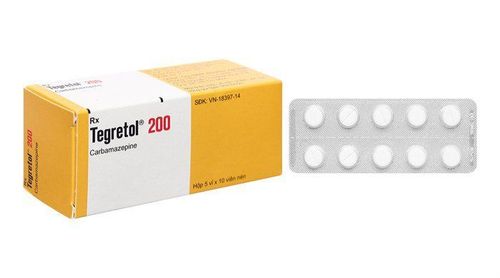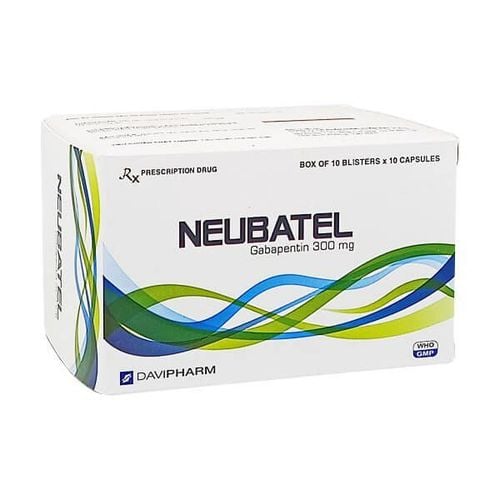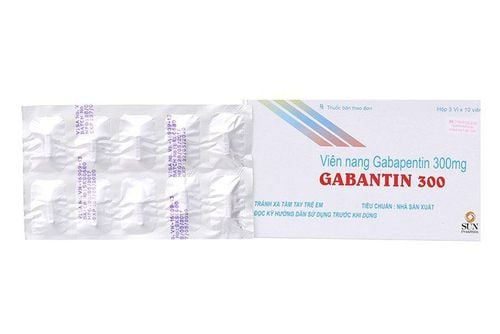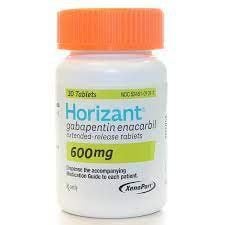This is an automatically translated article.
Tirastam 500 is made in the form of tablets, with the main ingredient being Levetiracetam. The drug is used in the treatment of epilepsy.
1. What is the use of Tirastam?
1 Tirastam 500 tablet contains 500mg Levetiracetam and other excipients. Levetiracetam is an antiepileptic drug that reduces the frequency of seizures in patients with epilepsy. Animal studies have shown that levetiracetam has the ability to inhibit seizures without affecting sensitive neurons. Levetiracetam is a selective, synchronous inhibitor of epilepsy.
Indications for use of Tirastam 500:
Single treatment for partial seizures with/without secondary generalization in people aged 16 years and older with newly diagnosed epilepsy; Combination therapy in: Treatment of partial seizures, with/without association with secondary generalized seizures in people 1 month of age and older; Treatment of myoclonic seizures in people 12 years of age and older; Treatment of generalized tonic-clonic seizures - primary seizures in people 12 years of age and older. Contraindications to the use of Tirastam 500:
Patients with hypersensitivity to the components of the drug.
2. Usage and dosage of Tirastam 500
Usage: Orally. Patients should take Tirastam 500 tablets with a sufficient amount of water, can be taken with or without meals. The daily dose should be divided equally into 2 doses.
Dosage:
Monotherapy for people 16 years of age and older:
Start with 250mg, 2 times a day and increase to a therapeutic dose of 500mg, 2 times a day after 2 weeks; Dosage may be increased by 250 mg twice daily for 2 weeks depending on clinical response. The maximum dose is 1500mg, 2 times / day. Combination treatment:
People 12 years of age and older, weighing over 50kg: The initial treatment dose is 500mg, 2 times a day. This dose can be started from the first day of therapy. Depending on clinical response and tolerability, the dose may be increased up to 1500 mg twice daily. May increase or decrease the dose of 500mg, 2 times / day every 2 - 4 weeks; Discontinuation of therapy: If levetiracetam therapy is to be discontinued, the patient should gradually reduce the dose before discontinuing it. People from 50kg or more can reduce 500mg, 2 times / day for every 2 - 4 weeks; Children over 6 months old and weighing less than 50kg reduce the dose not more than 10mg/kg, 2 times/day for every 2 weeks; Children under 6 months old reduce the dose not more than 7mg/kg, 2 times/day for every 2 weeks; Elderly (over 65 years old): Dosage should be adjusted if the patient has impaired renal function; Patients with Renal Impairment: The daily dose of Tirastam is individualized based on renal function (creatinine clearance). Specifically: Clcr > 80ml/min/1m73m2: Take a dose of 500 - 1500mg, 2 times/day; Clcr 50 - 79ml/min/1m73m2: Use dose 500 - 1000mg, 2 times/day; Clcr 30 - 49ml/min/1m73m2: Use dose 250 - 750mg, 2 times/day; Clcr < 30ml/min/1m73m2: Use dose 250 - 500mg, 2 times/day; End stage kidney disease - on dialysis: Use dose 500 - 1000mg, 1 time / day. The recommended loading dose is 750mg for the first day of levetiracetam administration. The recommended additional dose is 250 - 500mg after dialysis; Patients with hepatic impairment: Patients with mild to moderate hepatic impairment will not require dose adjustment of Tirastam. In patients with severe hepatic impairment, the daily maintenance dose should be reduced by 50% if the creatinine clearance is less than 60ml/min/1.73m2. Pediatric patients: Doctors need to prescribe drugs with appropriate dosage forms and levels according to age, weight and dose for children. Tablets are not suitable for children under 6 years of age, but Levetiracetam oral solution should be used. In addition, the tablet dosage form with available strengths is also not suitable for the initial treatment of children weighing less than 25 kg or for patients unable to swallow tablets or for doses less than 250 mg. In these cases, Levetiracetam oral solution should be used. Overdose: When using an overdose of Tirastam 500, patients may experience drowsiness, agitation, impaired consciousness, aggression, respiratory depression and coma. In the event of an acute overdose, the patient may be induced vomiting or gastric lavage to remove the drug from the gastrointestinal tract. There is currently no specific antidote for the Levetiracetam component. The management of overdose is mainly symptomatic treatment, possibly hemodialysis.
Missed dose: When forgetting to take a dose of Tirastam, the patient should consult a doctor about the use of the drug. Patients should absolutely not take a supplemental dose without the doctor's permission.
3. Side effects of the drug Tirastam 500
When using Tirastam 500, patients may experience some side effects such as:
Infections and parasitic infections: nasopharyngitis, infection; Blood and lymphatic system: Thrombocytopenia, leukopenia, pancytopenia (bone marrow suppression in some cases), agranulocytosis, neutropenia; Immune system: Drug reactions with eosinophils, systemic symptoms, hypersensitivity (angioedema and anaphylaxis); Metabolism and nutrition: Anorexia (risk is increased with concomitant use of Levetiracetam with Topiramate), weight loss, weight gain, hyponatremia; Psychiatric: Depression, anxiety, stress, insomnia, excitability, hostility, suicidal thoughts and attempts, hallucinations, anger, confusion, unusual behavior, mood/emotional instability, agitation, suicide, abnormal thinking, personality disorder; Nervous system: Headache, somnolence, convulsions, dizziness, balance disorder, tremor, lethargy, amnesia, memory impairment, paresthesia, concentration disorder, ataxia, chorea dancing, hyperactivity, movement disorders; Eyes: Blurred vision, double vision; Ears and labyrinth: Dizziness; Respiratory - thoracic - mediastinal: Cough; Gastrointestinal: Abdominal pain, dyspepsia, diarrhea, nausea, vomiting, pancreatitis; Hepatobiliary: Abnormal liver function test results, hepatitis, liver failure; Skin and subcutaneous tissues: Rash, alopecia (in many cases reversible upon discontinuation of Levetiracetam), skin pruritus, eczema, erythema multiforme, Stevens - Johnson syndrome, toxic epidermal necrolysis; Muscle - bone - joint - connective tissue: Muscle pain, muscle weakness; Body as a whole: Asthenia, fatigue; Trauma, poisoning, procedural complications: Trauma. Patients should promptly inform their doctor about the side effects they experience when using Tirastam 500 for instructions on how to best handle it.
4. Be careful when using Tirastam 500
Some notes that patients should remember before and while using Tirastam:
Use Tirastam 500 at the right dose, as prescribed by the doctor; Use caution when using Tirastam 500 in patients with severe liver failure; Levetiracetam should be discontinued gradually to avoid an increased risk of seizures; Do not drink alcohol while using Levetiracetam because it can increase the side effect of drowsiness; Levetiracetam is not recommended for use in pregnant women and women of childbearing age who are not using contraception (unless clearly needed). If used, adequate clinical control should be ensured in pregnant women treated with levetiracetam; Levetiracetam is excreted in human milk, so its use in nursing women is not recommended. If treatment with levetiracetam is necessary, the benefits/risks should be weighed against the importance of breastfeeding; Levetiracetam may cause drowsiness or other central nervous system related symptoms. Therefore, it should be used with caution in patients who need to perform skilled work such as driving, operating machinery, ...
5. Drug interactions Tirastam 500
Drug interactions may have some effect on the action/effectiveness of the drug or increase the side effects. Some of the drug interactions of Tirastam 500 include:
Study data showed that Levetiracetam did not affect the blood concentrations of antiepileptic drugs (phenytoin, valproic acid, phenobarbital, carbamazepine, lamotrigine, gabapentin and primidone) in the blood. bar. These antiepileptic drugs also did not affect the pharmacokinetics of Levetiracetam; There is no evidence of a clinically significant interaction in children receiving doses of Levetiracetam up to 60 mg/kg/day; An interaction assessment performed in children 4 to 17 years of age showed that the combined treatment of oral levetiracetam with carbamazepine and valproate had no effect on plasma concentrations of these two drugs. Therefore, users do not need to adjust the dose of these drugs; Probenecid at a dose of 500 mg 4 times a day is an inhibitor of tubular re-secretion but does not inhibit renal clearance of levetiracetam; Concomitant use of levetiracetam with methotrexate reduces the elimination of methotrexate, leading to increased or prolonged blood concentrations of methotrexate, even toxicity. Therefore, it is necessary to closely monitor blood levels of levetiracetam and methotrexate in patients using these two drugs simultaneously; The dose of Levetiracetam 1000 mg/day did not affect the pharmacokinetics of oral contraceptives (ethinyl-estradiol and levonorgestrel) and did not alter endocrine parameters (LH and progesterone). Doses of Levetiracetam 2000 mg/day did not affect the pharmacokinetics of warfarin and digoxin, and did not alter prothrombin time. Concomitant use of Levetiracetam with these drugs did not affect the pharmacokinetics of Levetiracetam; The extent of absorption of Levetiracetam is unchanged by food, but the rate of absorption is slightly reduced; There is currently no information on drug interactions between Levetiracetam and alcohol. When prescribed to use Tirastam 500, patients should share with their doctor about their medical history, the drugs they are taking to be considered for appropriate adjustment. At the same time, patients should not self-medicate, stop taking or change the dose of the drug without consulting the doctor.
Follow Vinmec International General Hospital website to get more health, nutrition and beauty information to protect the health of yourself and your loved ones in your family.
Please dial HOTLINE for more information or register for an appointment HERE. Download MyVinmec app to make appointments faster and to manage your bookings easily.













